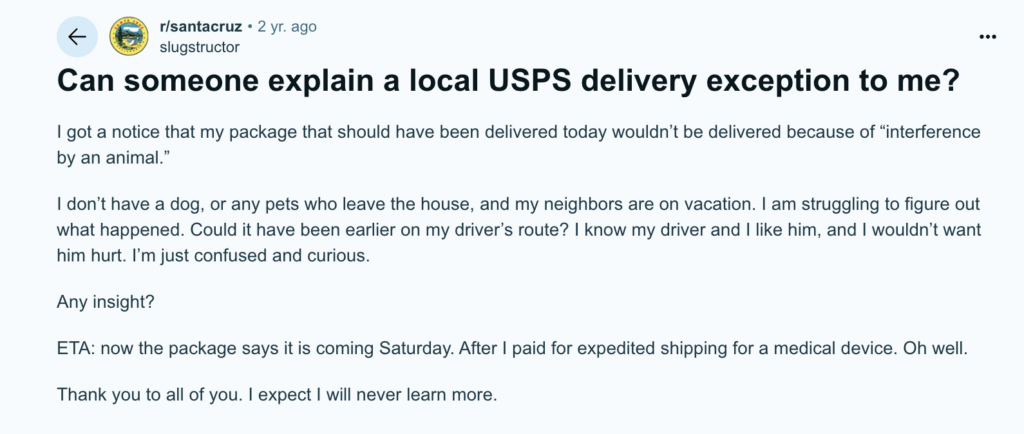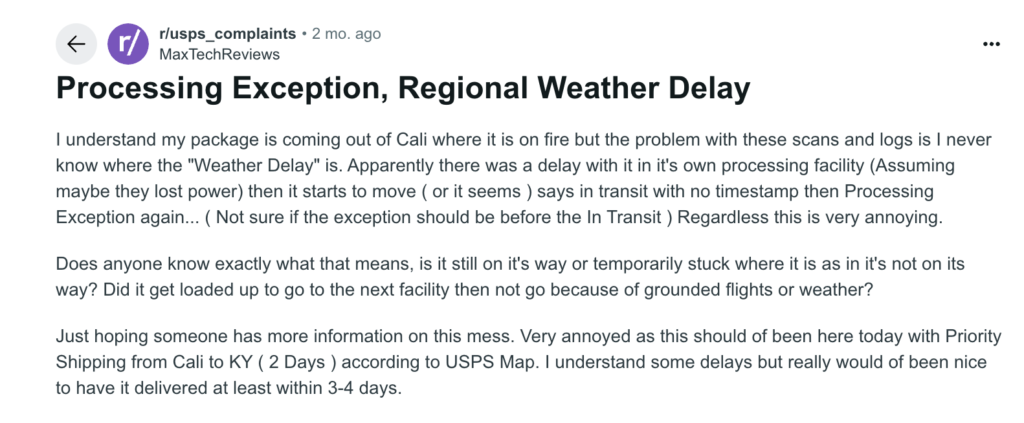Congratulations on the sale. You print the shipping label, dispatch the package, and your customer is pleased—until an all-too-familiar alert pops up: “Your package has a delivery exception” from USPS.
Suddenly, a dissatisfied customer threatens a negative review and demands a refund, leaving you scrambling for answers.
Recent data shows that 62% of online shoppers have experienced delivery exceptions, and when this occurs, 78% expect the retailer to resolve the issue, even if the carrier is at fault.
Delivering excellent service requires understanding each tracking status, whether it reads “order not due for delivery” or “package held by the carrier,” and knowing how to respond efficiently.
This article examines USPS delivery exceptions, explores their different types, and offers guidance on identifying them.
Continue reading to gain valuable insights.
What is a USPS Delivery Exception?
A USPS delivery exception occurs when a package encounters an unexpected pause during its journey, a temporary hiccup that doesn’t automatically spell a delay. This alert, issued by the carrier, signals that something unusual has affected the transit process, likely due to weather, an address mismatch, or another unforeseen circumstance.
Although a delivery exception might seem alarming, it doesn’t always mean the package will arrive late. With modern tracking systems, customers can get real-time updates to adjust shipping details, schedule redelivery, or address the issue promptly.
A delivery exception indicates that an unforeseen event affected the delivery rather than confirming a delay.
Types of USPS Delivery Exceptions
Here’s a breakdown of common USPS shipment exception types:
Label Issues
Label issues often lead to delivery exceptions; there’s more to it than meets the eye. When essential details on a shipping label are damaged or incorrect, it triggers a cascade of problems.
For example, a damaged label or an unscannable barcode can prevent proper routing, while a wrong or missing address means the package might not even reach its intended destination.
These label failures can result in significant delays or undeliverable packages, ultimately costing time and money.
Missing documentation
Missing documentation often emerges as a critical stumbling block in the shipping process. In many cases, the package simply lacks the required documents to reach its destination.
While this issue is relatively rare with local or ground freight, it becomes more prevalent with ocean freight, where a host of documents is necessary to manage inventory and establish custody.
Also, errors can occur when the shipping label is incomplete, such as lacking the proper barcode, further complicating the shipment’s journey. These documentation gaps can trigger delays or even derail the delivery entirely.
Holidays
Holidays introduce a unique set of challenges in the delivery process. Delivery employees take a well-deserved break from their routine duties on federal holidays, so scheduled delivery dates are often pushed back.
During peak holiday seasons, the sheer volume of shipments increases dramatically. That spike in activity and off days can quickly lead to a backlog of shipments, triggering delivery exceptions.
Moreover, while post offices might remain open on national holidays, their operations are typically limited, they often don’t process deliveries or pickups on these days.
Loss and damage
Loss and damage incidents reveal the unpredictable nature of shipping. Despite carriers’ best efforts to ensure a seamless process, packages can sometimes be misplaced or damaged during transit.
When such incidents occur, carriers typically halt further shipments and return the package to the delivery station.
They then issue a “Damaged” or “Lost” delivery exception notice. This alerts shippers to the status of the shipment.
Bad weather
Various conditions, from hurricanes, tornadoes, and hailstorms to flooding, wildfires, and even earthquakes, can render delivery routes impassable and create substantial delays on interstates and highways.
These unpredictable events, often classified as acts of God, mean that refunds for delays are generally not available. When you see a notification stating, “Your shipment has potentially been delayed due to emergency or other conditions,” it may signal a severe weather event or another disaster impacting the delivery network.
Pick up issues
Pick-up issues often emerge as a critical point of failure in the shipping process, and they are frequently rooted in errors on the shipper’s side.
For example, delays can occur when shippers fail to place orders promptly, mishandle the package handoff to drivers, or provide an incorrect shipping address that prevents the carrier from accepting the package into their system.
Beyond these common errors, external factors such as inclement weather and capacity constraints can also disrupt the scheduled pick-up.
In such cases, even if all internal processes are followed correctly, a driver might still be unable to collect the shipment at the designated time, further complicating the logistics chain.
Recipient unavailable
The process hinges on the available recipient when a package requires a signature. If no one is home, the business is closed, or there isn’t anyone authorized to sign, the carrier is forced to return the package to its fulfillment center and try again the next day.
In this scenario, the absence of a recipient directly disrupts the delivery process. It may be beneficial to encourage customers to use carrier-delivery management tools to schedule deliveries when they are certain to be available, thus reducing the risk of delays and reattempts.
Animal interference
USPS delivery exception animal interference emerges as an unexpected factor that can disrupt the delivery process. In some cases, carriers may find themselves at risk whether due to a pet, a stray dog, a wild animal, or even a swarm of bees blocking the delivery route.
Such encounters force carriers to delay or reroute deliveries to avoid potential harm, highlighting the unpredictable challenges within the logistics chain.
Impact of USPS Delivery Exceptions on Customers
- Customers experience longer wait times for their packages, which can disrupt plans and expectations.
- Exception notices create ambiguity about package status, leaving customers unsure when deliveries will occur.
- Reattempts and rescheduled deliveries may result in extra fees or inconvenience arranging alternative pickups.
- Repeated delivery issues lead to dissatisfaction and stress, impacting the overall customer experience.
- Critical or perishable items may suffer delays that affect their usability or freshness.
- Limited or unclear notifications can leave customers without adequate information on resolving the issue.
- Persistent exceptions may erode customer confidence in USPS as a dependable shipping partner.
How to Identify a USPS Delivery Exception?
Here’s how you can identify a USPS delivery exception:
Tracking Package Status
Begin by routinely checking the package status through USPS tracking systems. This initial step provides a snapshot of your shipment’s current location in the delivery process.
If you notice any unusual updates or stops along the route, such as delays or a halt in movement, it could signal that an exception has occurred. The tracking status serves as your first clue, prompting further investigation.
Delivery experience management software
Modern solutions, like delivery experience management software, elevate your tracking capabilities. These tools do more than display raw data; they analyze the delivery journey in real-time and flag deviations from the expected course.
Understanding tracking updates
Delve deeper into the language and details provided by tracking updates. USPS uses specific phrases such as “Delivery Attempted – No Authorized Recipient” or “Package Delayed Due to Weather”, indicating particular exceptions.
Hence, when you familiarize yourself with these standard updates, you can better interpret the situation and understand the potential causes of delays or issues, setting the stage for targeted problem-solving.
Recognizing exception notifications
Keep an eye out for official exception notifications, often email alerts or special messages within the tracking portal. These notifications mark the shipment with terms like “Delayed,” “Held,” or “Returned.”
Recognizing these labels quickly is crucial because it allows you to identify that something has gone awry and that the package is not following its intended path, prompting immediate attention.
Monitoring historical trends
Monitoring historical trends starts with comparing your current tracking data with what’s happened in the past. This lets you notice if specific routes, destinations, or timeframes regularly cause issues.
Once you spot these patterns, you can adjust your logistics strategy ahead of time to help prevent future exceptions.
Customer Feedback and Communication
Listen to your customers. Direct feedback through calls, USPS delivery exception email, or social media can often be the first indicator of a delivery problem. Customers may report missing or delayed packages long before you notice anomalies in tracking data.
Incorporating this feedback into your investigation process provides a valuable, real-world perspective on the issues, complementing the digital data and ensuring a comprehensive understanding of the situation.
How Do I Fix the Delivery Eexception with USPS?
Even the best shipping systems can hit a snag now and then. Delivery exceptions don’t have to throw your eCommerce game off track. You can keep things running smoothly with quick action and the help of delivery experience management software. Here’s how:
1. Give Your Carrier a Ring
Don’t wait, contact your courier when you spot a delivery exception. Ask them where your package is and what’s causing the hiccup.
With delivery experience management software, you can get real-time alerts and detailed tracking insights that make this step a breeze. Plus, if your customer has tracking info, they can join the conversation!
2. Touch Base with Your Customer
If a delivery hiccup, such as an incorrect address or miscommunication, arises, don’t wait; reach out to your customer immediately. A quick, friendly call or message to confirm details and offer a genuine apology can smooth things over.
With LateShipment’s delivery experience platform, you’re instantly notified about potential issues, such as bad addresses, so that you can address them immediately. The system even lets you automatically generate updated shipping labels and pre-fill customs declarations to minimize problems.
Plus, you can edit important information, like addresses, later in the fulfillment process to keep everything running smoothly.
3. Resend or Refund, and Make It Right
When a delivery exception means a package wasn’t delivered, it’s time to reship it or issue a refund. You might even get compensation for any damaged goods if you have shipping insurance.
With the insights provided by your delivery experience management software, you can quickly assess the situation and choose the best solution to keep your customers satisfied.
How to Prevent USPS Delivery Exceptions?
Here’s how to prevent USPS delivery exceptions:
Verify the address
Use address verification systems to ensure customers accurately fill in their shipping details. This little check will smooth the entire delivery process and build customer trust. Additionally, it cuts down on those annoying delays and mix-ups that can tarnish your brand’s reputation.
Partner with reliable Delivery carriers
Team up with well-known carriers with a solid track record in delivering packages on time. Even though no carrier is perfect, partnering with reliable shipping pros can significantly reduce the chance of exceptions and help your packages arrive like clockwork.
Keep Your Supply Chain Agile
Even the best-laid plans can encounter unexpected bumps, such as vehicle breakdowns or roadblocks, but a well-optimized logistics strategy can help.
Consider spreading your inventory across multiple fulfillment centers so orders ship from the closest location. This will keep your supply chain nimble and ready to roll, even when surprises pop up.
Weatherproof Your Package
Bad weather can wreak havoc on labels, making them unreadable. Invest in waterproof labels and sturdy packaging materials to ensure that rain, snow, or any other storm doesn’t obscure your package information.
Here’s a simple checklist you can print out to make sure everything is right before shipping:
- Verify shipping addresses using address verification tools
- Partner with reliable carriers with strong on-time delivery records
- Optimize logistics by distributing inventory across multiple fulfillment centers
- Use weather-resistant labels and durable packaging materials
- Monitor delivery updates with delivery experience management software
- Communicate proactively with customers about delivery status and scheduling
- Ensure proper packaging to prevent transit damage
- Provide clear and detailed delivery instructions
- Review historical delivery data to identify and address recurring issues
USPS Policies Regarding Delivery Exceptions
When things go sideways during delivery, USPS doesn’t just leave you in the dark. They have specific policies in place to handle what they call delivery exceptions—those pesky interruptions that stop your package from getting from Point A to Point B on time.
Here’s how USPS handles it when your shipment hits a snag:
- Tracking status update: USPS will mark the shipment with a clear status like “Delivery Attempted – No Access to Delivery Location” or “Held at Post Office”. These updates serve as your first clue that something didn’t go as planned.
- Reattempts & reroutes: In most cases, USPS will make another delivery attempt or hold the package at the local post office for pickup. Either way, they aim to get the package into your customer’s hands without needing a second label.
- Package holds & returns: If the issue can’t be resolved—think incorrect address, recipient unavailable, or restricted access—USPS may hold the package temporarily or send it back to the sender after a set window.
- Communication with recipients: Depending on the service level, USPS may leave a notice (the old-school way) or push an alert via email or text, letting the customer know what’s next and how to take action.
- No refunds for “acts of God”: If weather, natural disasters, or other uncontrollable events cause delays, don’t expect compensation. USPS classifies these under “force majeure,” meaning they’re off the hook for refunds in those scenarios.
USPS will let you know when a delivery exception occurs—but it’s often up to the sender or merchant to take action. That’s where tools like LateShipment.com can step in to help track these exceptions, send alerts, and keep your customers in the loop—without lifting a finger.
Real-Life Examples of USPS Delivery Exceptions
Example 1

Read the real-life example above…
In the end, while the exact animal culprit remains a mystery, the delivery exception has been triggered by an unexpected encounter along the route. The package was rescheduled for Saturday, far later than the expedited promise, leaving our customer with amusement and mild frustration.
How It Could Have Been Solved?
Here’s where a bit of a modern solution could have helped smooth things over:
- Real-Time Tracking: With advanced delivery experience management software, the shipper and the recipient could get live updates, pinpointing exactly where the unexpected hiccup occurred. Knowing what happened in real-time can help calm nerves and speed up a resolution.
- Clearer, Friendlier Communication: The carrier’s more detailed notifications could have illuminated the incident. If the update had included a friendly note like, “We encountered a little animal interference on the route,” it might have taken the sting out of the delay.
- Smart Route Planning: Carriers might analyze historical delivery data to spot routes that sometimes have these wild surprises. With this insight, they could adjust their routes or plan extra attempts during peak times, keeping delays to a minimum.
How can LateShipment help?
LateShipment’s Smart Incident Alerts keep you informed with pinpoint accuracy. You receive a real-time notification when an issue like delayed delivery, failed attempt, or lost package occurs. This lets you quickly investigate and resolve the problem before it spirals into customer frustration, ensuring that every hiccup is managed proactively.
Example2

A customer awaited a priority package from California to Kentucky, only to encounter a baffling “Processing Exception, Regional Weather Delay.” The tracking updates were unclear: the package appeared stuck in a processing facility due to possible power outages or weather disruptions, then resumed transit with no clear timestamps before hitting another processing exception.
This confusing situation, especially for a time-sensitive shipment, left the customer frustrated and unsure whether the delay was due to grounded flights, inclement weather, or a combination of issues.
How It Could Have Been Solved?
Enhanced real-time tracking through delivery experience management software could have clarified the package’s exact status, pinpointing whether the delay was due to processing or weather.
Clear, detailed notifications would have set proper expectations. Proactive contingency measures, such as alternative routing during severe weather, could have minimized delays, ensuring that critical shipments like this arrived on time.
How can LateShipment help?
With the integrated Helpdesk Shipping Widget, your support team can access detailed order status information inside your helpdesk. This feature streamlines troubleshooting by giving agents all the data they need to provide fast, informed responses. Resolving delivery issues on the spot directly reduces support tickets and enhances customer satisfaction.
How Can LateShipment.com Help?
Do you wish you could dodge those annoying delivery exceptions that ruin a great customer experience? While you can’t eliminate them, you can stay one step ahead with LateShipment.com. Our delivery experience management software is your secret weapon for fixing problem orders before they snowball into negative reviews.
You get smart alerts when a delay, lost package, or failed delivery attempt occurs, so you can nip issues in the bud. With automated notifications, you can keep your customers in the loop, and your support team can quickly resolve problems using our integrated helpdesk shipping widget.
This means fewer headaches, happier customers, and more repeat purchases, all while reducing customer service costs.
Interested in transforming your delivery experience? Get on a call with us to find out more!


